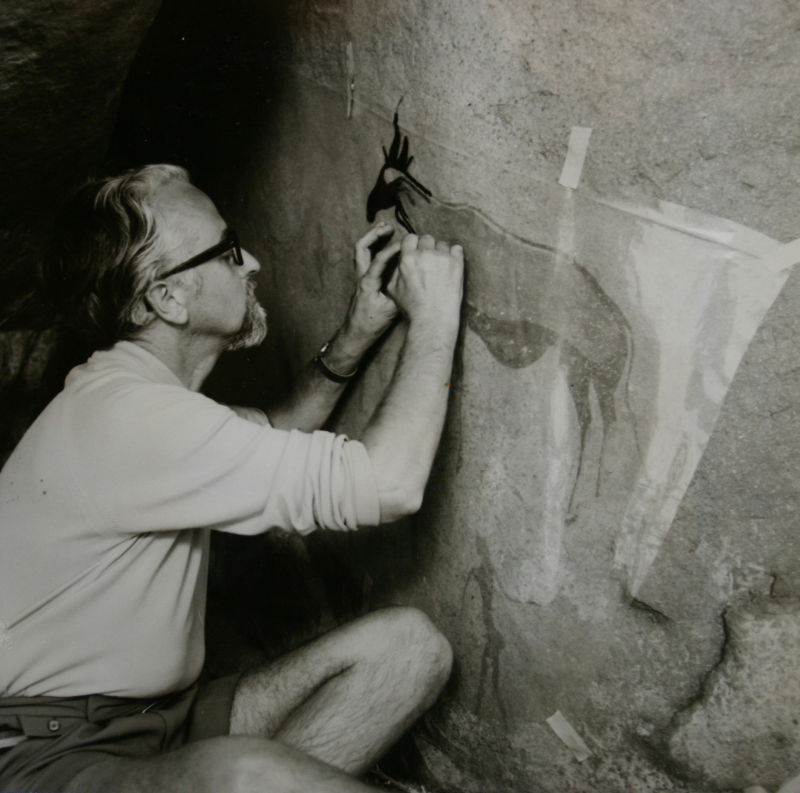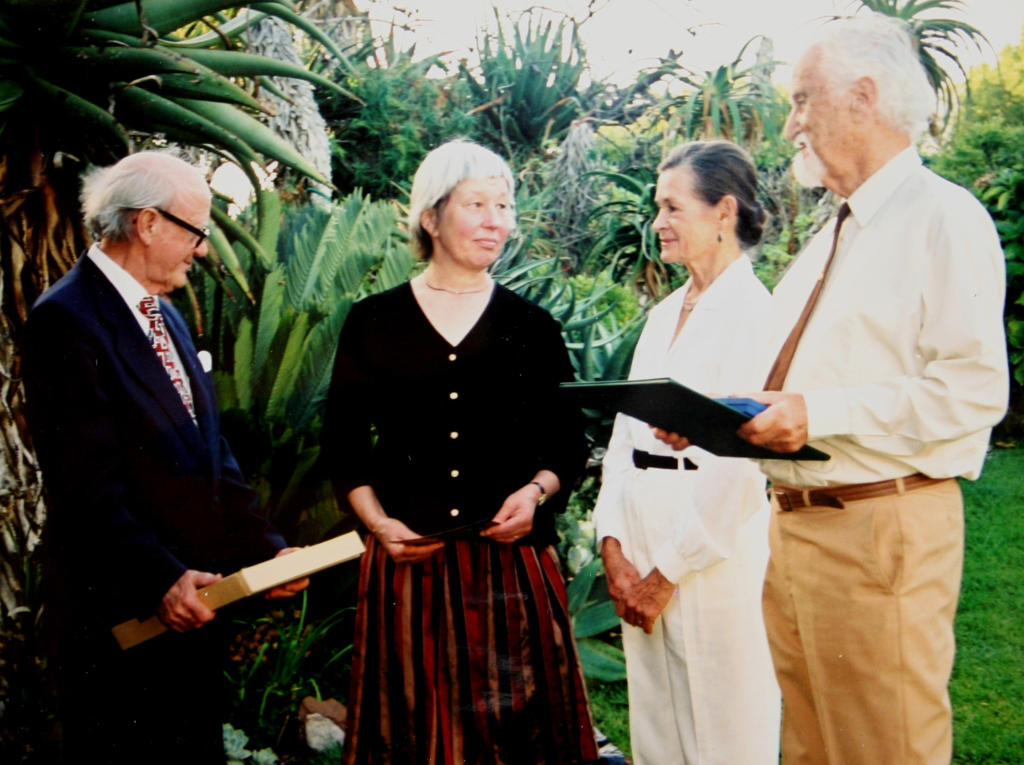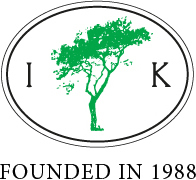Ione at desk with Apostles collection. Photo by Bjorn Rudner
The volumes recording the achievements of the Linnaeus Apostles – a treasure-trove of knowledge – take pride of place in my library, and is yet another aspect of Swedish influence in my life.
My Swedish husband Jalmar came to South Africa in 1949; an architect and town-planner, he was almost immediately employed by the Cape Town Municipality to plan most of the city's freeways. With our marriage in 1950, we became partners in studies and research work on Southern African prehistory, history, and indigenous cultures, and built up a sizeable library. We were drawn to the historical accounts of journeys in Southern Africa, including those of Sparrman and Thunberg which were, fortunately for me, available in English.
On our first visit to Sweden in 1953, Dr Gerhard Lindblom of the Ethnographical Museum in Stockholm invited us to examine Sparrman's ethnographic collection from South Africa (then kept in boxes in the basement), and to write a paper on which the museum published in 1957.
On subsequent visits we scoured second-hand bookshops for other books by early Swedish travellers not only for our studies but also to translate so as to make them available to others. That of the young naturalist J.F. Victorin,
Travels in the Cape the years 1853-1855 was the first to be published, in 1968.
In those early years we had received informal training in archaeology from Prof. A.J.H. Goodwin of the University of Cape Town and through him became associated with the South African Museum, I from 1955 as an honorary part-time assistant in ethnology (the upbringing of two small boys permitting), Jalmar from 1956 as honorary archaeologist as the museum did not have an archaeologist. We worked in the dusty archaeological store during week-ends if there was time to spare from field-trips.

Jalmar tracing rock art in the Brandberg mountains - Namibia. Photo by Ione Rudner.
During leave time winter months were devoted to inland expeditions, summers to coastal sites of prehistoric beachcombers (Strandlopers) along almost the entire coast of Namibia and South Africa. Frequently the children came along. ('Oh not another expedition!) Jalmar's monograph on our coastal work was published by the Museum in 1968, our comprehensive book on rock art appeared in 1970. Snippets of information for these were gleaned from both Sparrman and Thunberg.
I became research assistant in palaeontology in 1964, and 9 years later editor of the museum's scientific publications for another 9 years. Invited to join a British Museum-Yale University 1966-67 palaeontological expedition to Basutoland (now Lesotho), I was fortunate to discover tiny
Megaszostrodon rudnerae, the oldest complete fossil mammal ever found. I had a moment of fame; one of the many journalists called me 'a housewife' – it's a man's world.
Still flushed with the success of our archaeological expedition with two close friends to Angola in 1971, where we were tracked by radio for our safety as Angola was already in a state of insurrection, but mainly in the north and east, we were requested by the Van Riebeeck Society (publishers of rare and valuable historical books and documents on South African history) to revise and correct the texts of Sparrman's London 1785 and 1786 English editions dealing with his travels in South Africa. Prof. Vernon Forbes, an acclaimed scholar, was to edit the publication. We compared the original English texts with that of the Swedish facsimile edition of 1968. As we progressed Vernon came regularly to discuss our suggested alterations with me before making final decisions. Volume I appeared in 1975, Volume II in 1979.
It was a most rewarding task, and in so closely following the text we could not but be awed by Sparrman's knowledge, enterprise, and bravery in trekking by ox-wagon into the hinterland.
In this busy time we were also working on translating and annotating the very interesting book by P. Möller (of Congo fame) on his journeys in south-western Africa. This was eventually published in 1974.
“
Again there was information to
be had from the two Apostles
”
Jalmar was carrying out research on Khoisan prehistoric pottery from inland sites (later published in 1989), and I on Khoisan paints and pigments in historical and present-day times (M.A.thesis published by the South African Museum 1982). Both projects included several expeditions to interview Khoisan peoples. Again there was information to be had from the two Apostles.
To our delight the Society requested us once again to work with Prof. Forbes by revising Thunberg's account of his travels in South Africa. Thrilled to have been given the task of writing a biography on Thunberg for inclusion in the introductory notes, I fell in love with Thunberg! This was published in 1986.
On ”retiring” in 1979, Jalmar stepped into a tailor-made job with the National Monuments Council, with which he had had dealings in his town-planning work, and for 9 years I had represented the museum on a National Monuments Council committee to investigate the preservation of rock art. After leaving the museum in l983, I assisted Jalmar in compiling catalogues of conservation-worthy buildings in country towns, even after his final retirement in 1989 – there had been a shortage of staff. Again the two Apostles were consulted for data on historical buildings and places.
Then came translations of several Swedish books – as before, we did rough translations together, I took over to revise, edit, compile the footnotes and get the lot on the computer. Mr Klas de Vylder of Stockholm had provided us with a copy of the handwritten journal (1873-75) of his great-uncle Gustaf De Vylder (who used a capital D), an entomologist whose collections from south-western Africa (now Namibia) are in museums in Sweden. Our annotated translation, published by the Van Riebeeck Society in 1998, was well received, especially by entomologists.
In 2000 Jalmar received the large Linnaues medal in silver 'for his scientific contributions especially concerning Swedish exploration in Southern Africa'. His health was failing, my time to devote to the rest of the projects was limited. Jalmar died in 2003.

Jalmar receives the Large Linnaeus Silver Medal (2000) of the Royal Swedish Academy of Sciences from Per Brink - with Carita Brink & Ione. Photo by Bjorn Rudner
After picking up the pieces, I continued to process the rough translations with the help of a stack of dictionaries. The journeys in south-western Africa of T.G. Een (1866-71), and E. Rosenblad (1894-98) were published in 2004 and 2007 respectively. I finalized our own biography on the renowned nineteenth-century Swedish trader and ornithologist in south-western Africa Axel Wilhelm Eriksson; we had been researching material both in Namibia and Sweden since l972 and included most of his letters (translated). The book appeared in 2008.
A challenge for me was to revise and annotate the rough translation from Norwegian of I. Schröder-Nielsen's book on his sojourn in the Transvaal – theold South African Republic – and his participation in the Anglo-Boer War on the side of the Boers. Published last year (2012), it was well received for providing new information on the war.
I found our almost forgotten last rough translation – E.J. Kärrström's story of a young adventurer's 18 years in South Africa during which he fought with the British colonial troops in indigenous wars, and later worked as a miner. Now finalised, it is to be published later this year.
These nineteenth-century travellers and adventurers each in his own way contributed to the knowledge of Southern Africa, and reflected a little of the spirit of adventure of the Linnaeus Apostles.
Hitherto information could be obtained from the writings of only a few of the Apostles; the wealth of knowledge garnered some 200 years ago by all the Apostles has now become available to scholars the world over through the publication of the volumes
The Linnaeus Apostles – Global Science & Adventure, truly a unique and masterly achievement by the The IK Foundation and its many collaborators.






 Sveaskog, Stockholm, Sweden
Sveaskog, Stockholm, Sweden




 LEARN MORE
LEARN MORE